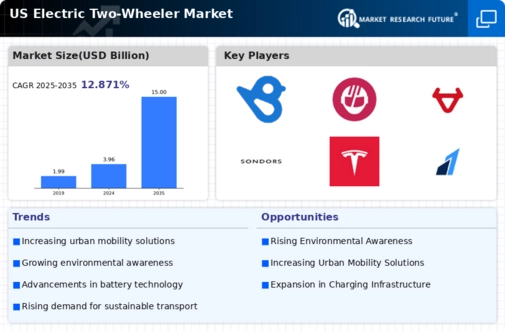Government Incentives and Subsidies
The electric two-wheeler market is experiencing a notable boost due to various government incentives and subsidies aimed at promoting electric vehicle adoption. Federal and state governments are offering tax credits, rebates, and grants to consumers and manufacturers, which can significantly reduce the overall cost of electric two-wheelers. For instance, consumers may receive up to $7,500 in tax credits for purchasing electric vehicles, making them more financially accessible. Additionally, manufacturers benefit from grants that can help offset production costs, encouraging innovation and expansion in the electric two-wheeler market. This financial support not only stimulates consumer interest but also fosters a competitive environment among manufacturers, leading to a wider range of options for consumers. As a result, the electric two-wheeler market is likely to see increased sales and market penetration in the coming years.
Urbanization and Traffic Congestion
The rapid pace of urbanization in the US is significantly influencing the electric two-wheeler market. As cities become more densely populated, traffic congestion has emerged as a pressing issue, leading to longer commute times and increased frustration among commuters. Electric two-wheelers offer a practical solution to this problem, providing a nimble and efficient mode of transportation that can navigate through congested urban environments. With an average commuting distance of around 16 km in urban areas, electric two-wheelers can effectively reduce travel time and enhance mobility. Furthermore, the compact size of these vehicles allows for easier parking and maneuverability, making them an appealing choice for urban dwellers. Consequently, the electric two-wheeler market is likely to thrive as more individuals seek efficient alternatives to traditional vehicles in crowded cities.
Rising Fuel Prices and Economic Factors
The electric two-wheeler market is being positively impacted by rising fuel prices and broader economic factors. As gasoline prices fluctuate, consumers are increasingly seeking cost-effective alternatives to traditional vehicles. The operational costs of electric two-wheelers are significantly lower, with electricity being a more affordable fuel source compared to gasoline. For example, the cost of charging an electric two-wheeler can be as low as $0.02 per km, compared to $0.10 per km for gasoline-powered bikes. This economic advantage is particularly appealing in times of high fuel prices, prompting consumers to consider electric options. Additionally, as the economy shifts towards more sustainable practices, the electric two-wheeler market is likely to see increased interest from cost-conscious consumers looking for long-term savings. This trend suggests a promising outlook for the electric two-wheeler market in the near future.
Environmental Awareness and Sustainability
Growing environmental awareness among consumers is driving the electric two-wheeler market. As concerns about climate change and air pollution intensify, more individuals are seeking sustainable transportation options. Electric two-wheelers produce zero tailpipe emissions, making them an attractive alternative to traditional gasoline-powered vehicles. According to recent studies, the transportation sector accounts for approximately 29% of greenhouse gas emissions in the US, prompting a shift towards cleaner alternatives. This shift is further supported by educational campaigns and initiatives that highlight the benefits of electric mobility. As consumers become more informed about the environmental impact of their choices, the demand for electric two-wheelers is expected to rise, contributing to a more sustainable future. The electric two-wheeler market is thus positioned to benefit from this growing trend towards eco-friendly transportation.
Technological Innovations in Battery Technology
Advancements in battery technology are playing a crucial role in shaping the electric two-wheeler market. Innovations such as lithium-ion batteries have led to increased energy density, longer ranges, and shorter charging times, addressing some of the primary concerns consumers have regarding electric vehicles. For instance, the latest battery technologies can provide ranges exceeding 100 km on a single charge, making electric two-wheelers more practical for daily use. Additionally, improvements in charging infrastructure, including fast-charging stations, are enhancing the overall user experience. As battery costs continue to decline, the affordability of electric two-wheelers is expected to improve, further stimulating market growth. The electric two-wheeler market is thus positioned to benefit from these technological advancements, which are likely to attract a broader consumer base.




















Leave a Comment